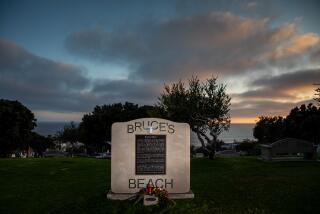Miles Along, Miles to Go
On certain blocks, young black men, some righteously enraged by injustice, some merely frenzied, dragged people from cars and beat them. Men, women and children--Latino, black, white--dragged stereos, jeans and disposable diapers through stores’ broken windows. By the third day of rioting, the view from a helicopter was of fires smoldering over 163 square miles--an area the size of three Bostons. About $1 billion in property was stolen or smashed or went up in flames.
No one who was here 10 years ago will forget. But more important now is to remember what the city was like before those days and nights of anarchy, to consider how it has changed, to imagine what it might be like 10 years from now.
The inchoate frustration in the hardest-hit neighborhoods followed years of disrespect and disenfranchisement: by police, corporations and civic leaders. Too little has been done to improve a police force that was often rude, if not brutal. Too few jobs have blossomed in the ashes. But the recovery, while incomplete, has been substantial.
About 85% of the 1,118 damaged or destroyed properties surveyed afterward by the Los Angeles Department of Building and Safety have been rebuilt. And the rebuilders didn’t come from Washington, despite promises from hordes of elected officials who paraded through the rubble, prayed at First AME Church and held press conferences.
Rebuild Los Angeles, created by then-Mayor Tom Bradley and then-Gov. Pete Wilson, helped to fill the void with an economic recovery targeted at encouraging private investment. RLA channeled more than $350 million in corporate investments into rebuilding, developing and expanding businesses. It also supported job training like the Toyota- Urban League partnership, which in June will graduate its 1,000th mechanic.
Such slow but significant change is raising the quality of life in other ways too. Take, for example, the return of supermarkets to the Crenshaw District and South-Central Los Angeles--32 since the riots. RLA started a trend continued by private developers. In South-Central Los Angeles, at Slauson and Western avenues, Chesterfield Square offers a Home Depot, Starbucks and Subway. A Radio Shack and an International House of Pancakes are planned.
The chains have rediscovered what the mom-and-pop stores already knew: There’s much money to be made in the central city.
Many Korean Americans, like immigrants before them, had staked their economic future on small, family-run shops. They were convenient targets for the rioters; about two out of three businesses destroyed were Korean-owned, according to the KoreAm Journal. Today, many Koreans feel worse off. Hundreds of families lost their livelihoods, their homes and their faith in the American dream.
This isn’t acceptable. Ten years from now, everyone in Los Angeles should have reason to share in the optimism of many Latino and black families. Buoyed by a rebounding economy, homeownership is up. A working father can pick up milk without driving miles out of his way, and his children now have reason to stay in neighborhoods that were bleak long before the riots.
More to Read
Sign up for Essential California
The most important California stories and recommendations in your inbox every morning.
You may occasionally receive promotional content from the Los Angeles Times.










